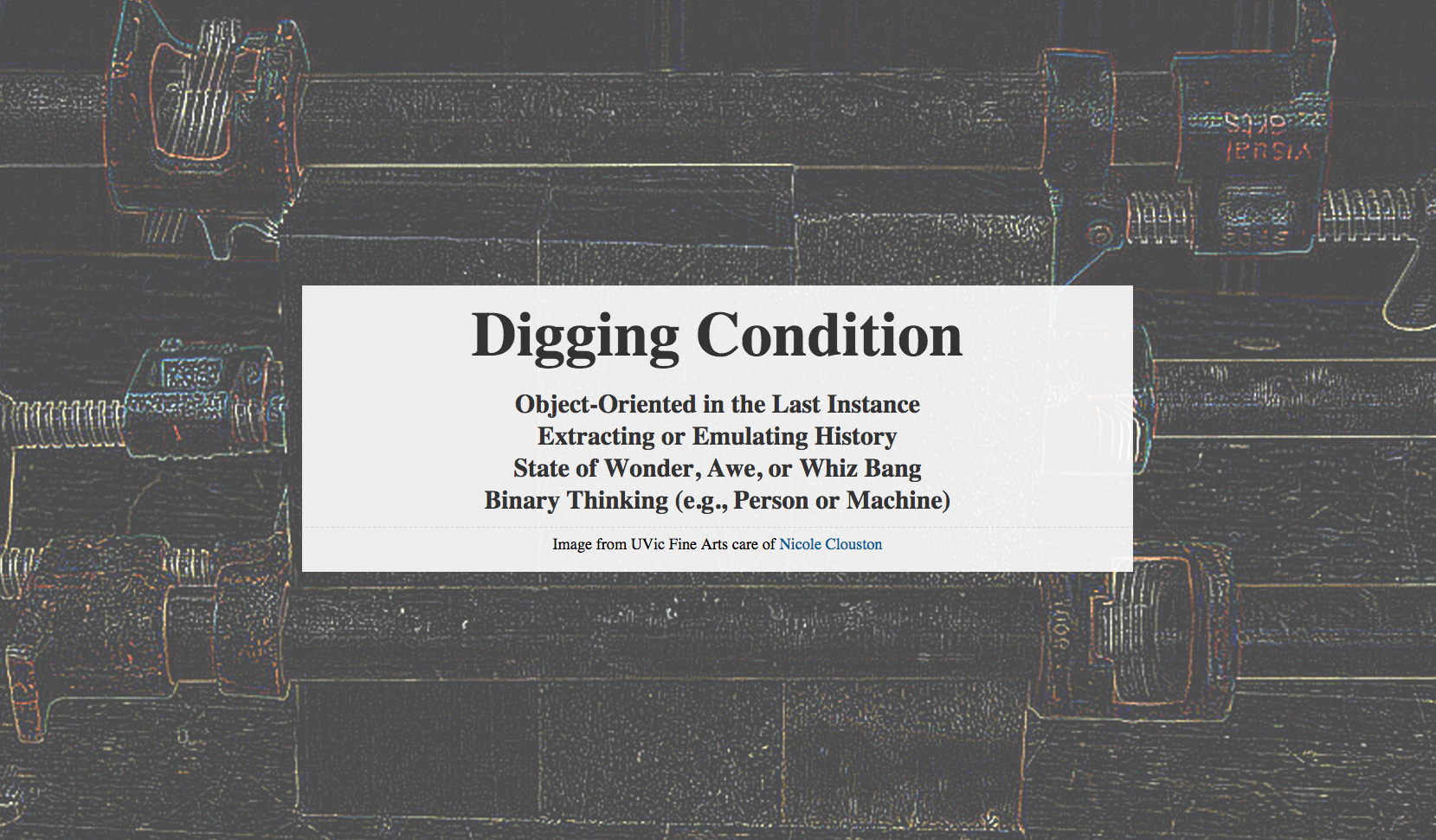Two weeks ago, I visited the University of South Carolina to give a “Future Knowledge” talk on “The Digging Condition,” which is the topic of the magnetic recording book I’m writing. Essentially, the digging condition is a state when—in digital humanities, media studies, and related fields—materiality wins in the last instance, or when we only think about data, software, hardware, and platforms as matter all the way down. As a response to this tendency, the book underscores not only how the materiality of media (including their ephemerality) is constructed but also how media history is most compelling when we don’t know, cannot recover, or must speculate about something. Here, I’m drawing largely from sound studies; however, the kits (in particular) and the MLab (in general) have significantly shaped my methodology, too.
Below are the abstracts for the talk and workshop I gave at South Carolina. I also published my slidedeck for “The Digging Condition” online (source files). The slidedeck unpacks various types of materiality I’m identifying in the book, and it concludes with magnetic recording as an object lesson. Thanks again to David Miller, Colin Wilder, John Knox, and Center for Digital Humanities for hosting me. I really enjoyed the trip.
“The Digging Condition: The Material Turn in Digital Humanities”
During the 2000s, a material turn occurred in digital humanities research, with an emphasis on how new media are not ephemeral info-dust. They are inscribed onto platters, embedded in infrastructure, transmitted through wires, and grounded in platforms. Put this way, the material turn responds, if only tacitly, to critical theories of technology, virtuality, and cyberspace that, during the 1980s and 1990s, largely ignored the particulars of how new media actually work. With this turn, we observe what I call a “digging condition” across digital humanities: scholars are now approaching media archaeologically, scraping data, emulating obsolete programs, reanimating dead tech, and unpacking the hidden lives of objects. But, from a historical perspective, how did new media become material in the first place? What motivated, say, the transduction of the ephemeral into the permanent? Engaging these questions, this talk argues that, among other things, early magnetic recording practices (1878 – 1920) should inform how we understand the emergence of the digging condition in digital humanities. In so doing, it uses sound studies as its foundation, building upon and often complicating tendencies in digital humanities to privilege book history, print culture, and electronic text.
“Prototyping the Past: An Introduction to 3D Modeling and Manufacturing for Historical Purposes”
3D modeling and manufacturing are now ubiquitous in the news. Regardless of whether people read Wired or Boing Boing, they have probably heard about 3D printing, Maker Media, or MakerBot. However, the relevance of 3D modeling and manufacturing to historical research in the humanities may not be readily apparent to most researchers, and for good reason. As such, this workshop introduces participants to some fundamentals of modeling and manufacturing historical artifacts in 3D, with an emphasis on how scholars can “prototype the past” through computer vision, laser scanning, and photogrammetry. Participants will learn how to digitize 3D objects using free and readily available software, render them “watertight” (or conducive to fabrication), assign them metadata, and circulate them online (for downloading, resuse, and printing). We will also review the importance of perceiving and thinking about history across analog and digital materials, including the ways in which code can be transduced into objects held in hand. No technical competencies or experience with 3D modeling and manufacturing is required. However, participants will be encouraged to share ideas (and even objects) related to their current research and to bring their own laptops, if possible. For examples, we will draw upon the Kits for Cultural History project at the University of Victoria’s Maker Lab in the Humanities: ./category/kits/. This project is supported by the Social Sciences and Humanities Research Council of Canada, and, in collaboration with researchers at Western University, it began in September 2013.
Post by Jentery Sayers, attached to the Makerspace and KitsForCulture projects, with the fabrication and news tags. Featured image for this post care of Jentery Sayers.

